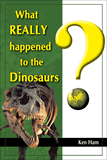Dinosaurs Haven’t Been Gone that Long
In the last decade there have been two crushing blows to the idea that dinosaurs died out some 65 million years ago.
In the last decade there have been two crushing blows to the idea that dinosaurs died out some 65 million years ago. The first blow was the discovery of unfossilized dinosaur tissue at the center of a T. rex bone by Mary Schweitzer of North Carolina State University. That discovery, and some papers written about it, started an intense debate about whether what they found really was unfossilized dinosaur tissue (see ).
Now scientists have found more soft (unfossilized) tissue from a hadrosaur, a duck-billed dinosaur supposedly from 80 million years ago. The new find confirms that there really is unfossilized tissue in some dinosaur bones.
But soft tissue is thought to last, at the very most, about 1 million years. During this time it would slowly be replaced by minerals, which eventually would result in a fossil. Finding soft tissue throws off the evolutionary timetable considerably, as evolutionary scientists insist that dinosaurs died out about 65 million years ago.
Of course, evolutionary scientists, instead of adjusting the dates of their timetable, are saying that they must be wrong about how long soft tissue can really last. They are committed to the “millions of years” story no matter what scientific discoveries are made. Imagine how they will try to explain things if someone ever finds a living dinosaur!
Recommended Resources
- © 2025 Answers in Genesis
- Privacy Policy
- Contact
- About


